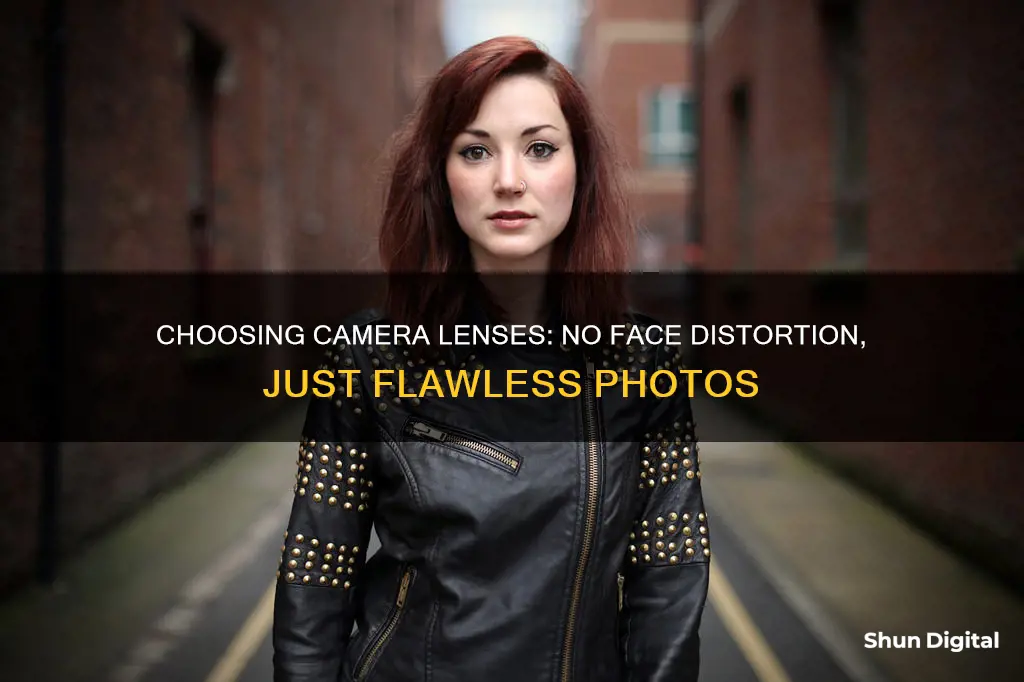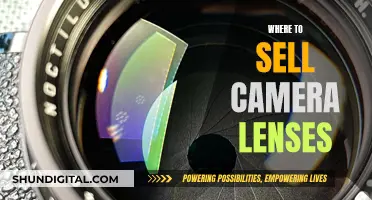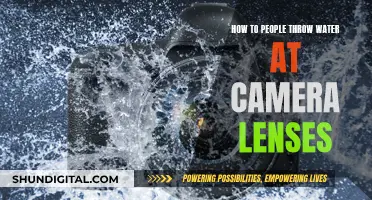
The lenses that distort your face the least are those with a longer focal length. This is because they require you to be further away from the camera, which tends to create a situation where facial features seem more proportionate.
The lenses that are most likely to distort your face are those with a shorter focal length, also known as wide-angle lenses. These lenses have a wider field of view, so you can get closer to the camera, but this means that the features closest to the lens seem larger and therefore disproportionate to the rest of the face.
The focal length of the lens is not the only factor that affects the distortion of your face in a photo. The distance between you and the camera also plays a big role. The closer you are to the camera, the more distorted your face will look. This is because the parts of your face that are closest to the camera will appear larger in the photo, while the parts that are farther away will appear smaller.
It's important to note that all photos are distorted to some extent and do not accurately represent how we look in real life. This is because cameras and lenses cannot capture the same perspective as the human eye, which can see an entire scene in stereo and use the brain to process it and take relative distance and perspective into account.
| Characteristics | Values |
|---|---|
| Camera lenses that do not distort your face | 135mm |
| Reason for distortion | The distance between the camera and the subject |
| Reason for distortion | The field of view of the lens |
What You'll Learn
- The distortion is due to geometry, not the lens
- The shorter the focal length, the more field of view you can capture
- The relative distance from the lens and the field of view of that lens are what will affect the look of the subject within the image
- The human brain will remember the proportions of a human face as it looks from about 12-15 feet away
- Lenses and sensors can't correct for distortion, but computers can

The distortion is due to geometry, not the lens
The distortion of a person's face in a photograph is due to geometry, not the lens. This phenomenon is called "forced perspective". It occurs because a camera, unlike the human eye, has only one "eye" and cannot use the brain to process a scene and take relative distance/perspective into account.
The distance between the camera and the subject is the main factor in this type of distortion. When taking a selfie, for example, the nose is much closer to the lens than the eyes, so the camera sees a nose that is super close and eyes that seem much further away. As a result, the nose looks larger.
The focal length of a lens does play a role in this type of distortion, but it is not the main cause. A wide-angle lens will allow you to see a larger slice of the scene in front of you, whereas a longer lens will cut out the sides and capture a smaller slice. However, the distortion is more about how close the camera is to the subject than the width of the lens.
The same person's face will look different depending on the distance from the camera and the focal length of the lens. This is why some people are considered "photogenic" – they have features that are flattered by certain lenses and angles.
It's important to note that all photos are distortions of reality. Even if a photo could capture a person's face exactly as it is, that is not what we would want. Portrait photographers use their skills to create images that make their subjects feel wonderful or boost their self-confidence.
Cleaning Camera Lenses: DIY Home Solutions
You may want to see also

The shorter the focal length, the more field of view you can capture
The focal length of a lens is the distance between the plane of the sensor and the optical centre or nodal point of the lens. This determines the lens's angle of view. The longer the focal length, the narrower the area of the scene captured by the lens. This means that a lens with a short focal length captures a much broader view than a telephoto lens.
The shorter focal length lenses are used in architectural, documentary, and landscape photography because they have a wide angle of view. These wide-angle lenses make subjects appear smaller, which requires photographers to stand closer to fill the frame. Short focal lengths are suitable for environmental portraiture, large groups, and small spaces.
Lenses can be divided into three broad categories according to focal length: wide-angle, standard, and telephoto. Wide-angle lenses are those with a focal length up to around 35mm. Standard lenses are those with a focal length of around 50mm, or more broadly from about 35mm to 85mm. Telephoto lenses are those with a focal length of around 85mm or more.
How to use focal length
Now that you know what focal length is and its effect on photography, here's how you can use it:
- Short focal length lenses are used in architectural, documentary, and landscape photography because they have a wide angle of view.
- Short focal lengths are suitable for environmental portraiture, large groups, and small spaces.
- Keep in mind that photos taken at short focal lengths will often experience distortion, particularly around the edges.
- 50mm is generally considered the focal length that most closely approximates the human field of view.
- Focal lengths from 70mm to 85mm and above are generally considered longer focal lengths, and they’re often referred to as “telephoto lenses.”
- Longer focal lengths are ideal for situations where you may want to remain unobtrusive, such as sports, wildlife, or wedding photography.
Understanding Camera Lenses: Long Focal Points Explained
You may want to see also

The relative distance from the lens and the field of view of that lens are what will affect the look of the subject within the image
The distance between the lens and the subject will impact the perspective and, thus, the distortion of the image. The closer the camera is to the subject, the more distorted the image will be. This is because objects that are closer to the camera will appear larger than objects that are farther away. This is true for both convex and concave lenses.
The field of view of the lens, also known as the focal length, will also impact the image. A wide-angle lens will allow you to see a larger field of view, capturing more of the scene in front of you. This is great for landscapes or group photos. A longer lens will have a narrower field of view, capturing less of the scene in front of you. This can be useful for portraits or for focusing on a specific subject.
The combination of the relative distance from the lens and the field of view of the lens will determine the final image. For example, if you are using a wide-angle lens and are standing close to the subject, their features closest to the camera will appear much larger than the features that are farther away. This can often result in distorted-looking facial features, such as a larger-looking nose.
To reduce distortion in portraits, it is recommended to use a longer focal length (at least 85mm) as this will produce a more "natural" and flattering image. Additionally, standing at a further distance from the subject will also help to reduce distortion.
It is also important to note that the lens and camera do not "see" in the same way that the human eye does. The human eye can view an entire scene in stereo and use the brain to process and take relative distance and perspective into account. The camera, on the other hand, has a mono-vision and cannot change the perspective in the same way that the human eye can. This is why images can often appear distorted, especially when the subject is very close to the camera.
Traveling with Camera Gear: Efficiently Packing Extra Lenses
You may want to see also

The human brain will remember the proportions of a human face as it looks from about 12-15 feet away
The human brain is an incredibly complex organ, with 86 billion neurons, 400 miles of capillaries, 100,000 miles of axons, and more than 10 trillion synapses. It has a memory capacity of around 2.5 million gigabytes of digital memory. To put that into perspective, the biggest hard drive to date can only store 10,000 gigabytes.
The human brain can hold up to 1 quadrillion pieces of information over a lifetime. That's 1,000,000,000,000,000 pieces of information! Our ability to remember new information peaks in our 20s and then starts to decline from our 50s or 60s.
Most of our memories come from when we were between 15 and 25 years old. This is known as the "reminiscence bump" and can account for 60% of all our memories.
The human brain processes and stores information differently from a camera. A camera captures a two-dimensional image of a scene, while the brain constructs a three-dimensional model of the world based on sensory input and past experiences. This allows the brain to fill in gaps and correct for distortions that a camera cannot.
When taking a photograph of a person, the distance between the camera and the subject is crucial. As the subject moves closer to the camera, their facial features that are closer to the camera will appear larger in the photograph. This is because the camera lens cannot accurately represent the three-dimensional structure of the face in a two-dimensional image.
The human brain, however, is adept at interpreting and remembering the proportions of a human face as it would appear in real life. It can compensate for the distortions caused by perspective and distance, creating a more accurate mental image.
When viewing a photograph, the brain may still be able to recognise and remember the proportions of the face, but this depends on various factors such as lighting, angle, and the viewer's familiarity with the subject.
In summary, the human brain has an incredible capacity for storing and processing information, including visual memories of faces. While a camera may distort the proportions of a face due to lens type and distance, the brain can often correct for these distortions, creating a more accurate mental representation.
Lens Compatibility: Can You Mix and Match Brands?
You may want to see also

Lenses and sensors can't correct for distortion, but computers can
Cameras distort everything, all the time. The photographer does too – that's their job. The camera doesn't just record what's there. The camera distorts everything.
The distortion is caused by the proximity of the subject to the camera. The closer the subject is to the camera, the larger they will appear. This is because the distance from the camera to the subject is greater than the distance from the camera to the background. This phenomenon is called forced perspective.
The distortion is not caused by the lens width but by the distance from the camera to the subject. A wide-angle lens will allow you to see a larger slice of the scene in front of you. A longer lens will cut out the stuff on the sides and just capture a smaller slice of the scene in front of you.
You can use distance from your subject, camera angle, lighting, and posing to dramatically change a person's appearance, all without even opening Photoshop or any editing app.
The answer is probably yes and no. There are too many variables to simplify into what you probably want to hear. There is no "yes" or "no" to this question—the answer is an infinitely complicated spectrum.
The lens and sensor form a system. An improvement in one of the components improves the MTF (modulation transfer function) of the system. Both components have their own MTF and combined, they give the MTF of the system.
The MTF of the sensor can be better than the MTF of the lens, but still, an improvement in one improves the MTF of the system.
If there is obvious or visible damage or dysfunction, minor issues can be quite hard to determine. You can severely compromise the front element of a lens and it will still mostly work. However, a scratch on a rear element will be much more noticeable.
If you have the ability to see images produced by a lens or camera body, you can look for some things such as dark spots, which may indicate dust or dirt on the lens, or banding, which may indicate some deeper malfunction. For a lens, the most common problems show up as poor focus or uneven focus across an image.
Testing Camera Lenses: The Ultimate Sharpness Guide
You may want to see also
Frequently asked questions
The distortion is caused by the distance between your face and the camera. The closer your face is to the camera, the more distorted it will look.
Move the camera further away from your face.
In theory, a focal length of around 135mm would produce the most accurate results, but it depends on your anatomy.
Yes, all photos are lies and distortions of the truth.
Videos have similar problems to photos when it comes to lens distortion, but because things are moving, the brain processes them in a more realistic way.







